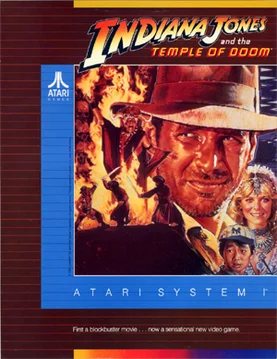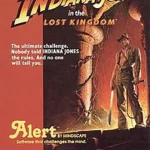Ahoy, adventurers! If you ever wanted to step into the rugged boots of the legendary archaeologist Indiana Jones, then 1985 was the time to do it! Released shortly after the iconic film, „Indiana Jones and the Temple of Doom,“ Atari Games brought this thrilling story to arcades with an action-packed game that was as tough and exciting as the movie itself. Did you know it was the first Atari System 1 arcade game to feature digitized speech? That’s right—voice clips of Harrison Ford and Amrish Puri brought the characters of Indy and Mola Ram to life like never before. With John Williams’s electrifying score setting the background, who wouldn’t want to take a digital whip into their own hands? So, grab your hat and hang on tight!
Table of Contents
The Birth of an Arcade Legend
You know, it’s funny how some of the best legends start. When Atari Games rolled out an arcade game in 1985 based on the Indiana Jones and the Temple of Doom movie, I was just this eager kid who couldn’t even reach the joystick without standing on my tiptoes. That game felt like a genuine innovation back then. Unlike anything I’d ever seen, it incorporated digitized speech—yup, you could actually hear Harrison Ford as Indy barking below his breath or yelling as if he were right next to you. It was groundbreaking, and it touched off a sort of arcade revolution.
The real magic was in the soundtrack. Those digital tunes? They rocked the gaming world harder than a boulder chasing Indy down a temple corridor. Rarely do video games and music merge so beautifully, and it genuinely made the experience more immersive. Thinking back, I used to save my measly allowance just to hear that bombastic soundtrack in the arcades. Crazy, right? But those were the days when technical advancements seemed like magic.
Gameplay: An Adventure Like No Other
Playing as Indiana Jones, I felt like the kingpin of adventure gaming. Your mission was to infiltrate the eerie Thuggee cult to rescue enslaved kids. With one hand gripping an eight-position joystick and the other poised over the whip button, you could practically taste the tension. It was all about timing, strategy, and a bit of luck—not unlike surviving a family BBQ when your uncle pulls out his karaoke collection.
The stages were ingeniously crafted. First, was the rescue mission, then a wild mine cart escape, and finally, retrieving the enigmatic Sankara Stones. Each stage brought its unique flavor of danger—sort of like eating a mystery jellybean and hoping it doesn’t taste like sock. The difficulty levels varied, with the ultimate showdown against Mola Ram being, for lack of a better word, bananas. I mean, who didn’t grow their first gaming grey hair trying to beat Mola?
Ports and Versions: Expanding the Adventure
The adventure didn’t end at the arcades. Nope, it got ported to just about every platform available back then—Amstrad CPC, Commodore 64, ZX Spectrum, and even onto fancier systems like the Atari ST and Amiga. Each port introduced its quirks. I remember my neighbor inviting me over to play the NES version by Tengen. It had its standout features but also, well, kinda left me longing for that gritty arcade feel.
Some versions were celebrated for maintaining the core essence, while others got a bit lost in translation. It was a mixed reception, much like introducing pineapple to pizza lovers—passionate debates ensued! But, no matter the differences, each port kept the spark of the Indy adventure alive for its players.
Reception: Hits and Misses
Here’s where things get interesting—initially, Indiana Jones and the Temple of Doom arcade game was a total hit, especially in Japan. Folks loved its upright arcade design and gameplay dynamic. But as it spread across platforms, opinions started to divide. It was praised for its playability but slammed for its, sometimes unforgiving, difficulty and slightly stubborn controls.
Take the Commodore 64 version; according to AllGame, it was slightly off the mark—a bit of a missed opportunity they said, suggesting the controls could’ve used a hearts-and-crafts session or two. However, isn’t it the quirks and frustrations that make these retro games so nostalgically charming?
Legacy: The Impact of an Icon
Even now, the game continues to influence modern gaming, holding a perpetual spot in the intriguing Indiana Jones franchise. It’s got that Indiana Jones film mystery factor, coupled with an arcade essence, living on among us retro gamers. There’s a reason it’s still celebrated—it strikes a balance between nostalgia and genuine gaming enjoyment. It’s the kind of game that, even years later, brings you back to an era where saving the day was a few coins away.
What makes it a gem, you wonder? Maybe it’s how it effortlessly shot players head-first into a familiar world full of adventure, challenge, and, honestly, a whole lot of love.
Conclusion
And there you have it—an in-depth look back at a game that brought the silver screen excitement of „Indiana Jones and the Temple of Doom“ to the palm of your hands! Whether you’re a seasoned retro gamer or new to the arcade scene, this game holds its charm in challenging and adventurous gameplay. Which stage was your favorite to conquer? Were those mine cart escapes as hair-raising as they seem? We’d love to hear your own Indy tales! Don’t forget, adventurers, fortune and glory await those who dare to play on!



